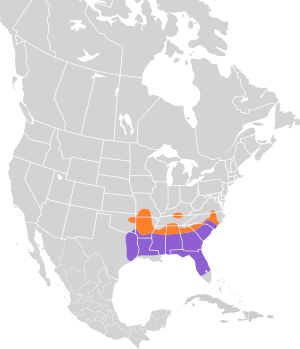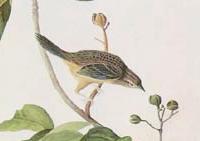Bachman's sparrow facts for kids
Quick facts for kids Bachman's sparrow |
|
|---|---|
 |
|
| Conservation status | |
| Scientific classification | |
| Genus: |
Peucaea
|
| Species: |
aestivalis
|
| Subspecies | |
|
Peucaea aestivalis aestivalis |
|
 |
|
| Synonyms | |
|
Aimophila aestivalis |
|
The Bachman's sparrow (Peucaea aestivalis) is a small bird found only in the southeastern United States. It's a type of American sparrow. This bird was named after a person called Reverend John Bachman.
These sparrows have reddish-brown feathers on their backs and heads. Their faces are gray, with a reddish-brown stripe near their eyes. Their chests are a light tan color, and their bellies are whitish. Bachman's sparrows are about 12 to 16 centimeters (5 to 6 inches) long. They weigh around 18 to 23 grams (0.6 to 0.8 ounces).
They like to live in open pine forests. Their nests are shaped like a dome and are usually built on the ground. They often hide their nests near a clump of grass or a small bush. Female sparrows usually lay three to five eggs.
Bachman's sparrows mostly stay in the same area all year. They don't usually migrate far. They mainly eat seeds, but they also enjoy eating some insects.
This bird is considered near threatened by the IUCN. This means their numbers are getting low. One big reason for this is that they are losing their homes (habitats). When forests change too much, it also hurts these birds. Helping their homes by using controlled forest fires can help them recover.
The Bachman's sparrow has a special song. It starts with a clear whistle, then ends with a short, fast trill.
Contents
Where Do Bachman's Sparrows Live?
Bachman's sparrows mostly live in the southeastern United States. You can find them from central Florida up to southeastern North Carolina. They also live west through parts of Tennessee, Kentucky, and Missouri, reaching eastern Oklahoma and eastern Texas.
Long ago, in the early 1900s, these sparrows spread their homes to more northern states like Illinois and Ohio. But then, many eastern forests grew back, and the sparrows' numbers went down in those areas. Now, North Carolina is one of the northernmost places you can find them in the east.
There are three types (subspecies) of Bachman's sparrows:
- Peucaea aestivalis aestivalis: Lives furthest east, from South Carolina to Florida.
- Peucaea a. bachmanii: Lives west of the first type, reaching Mississippi and Kentucky.
- Peucaea a. illinoensis: Lives in the westernmost part of the sparrow's range.
Life Events of the Bachman's Sparrow
Do Bachman's Sparrows Migrate?
Most Bachman's sparrows in the southern parts of their range stay put all year. However, some sparrows from northern areas like Missouri or Tennessee might fly south for the winter.
When they do migrate, they usually fly north in spring from mid-March to May. They fly south in fall from late August to late October. It's hard to know exactly when they move because they are very shy. They don't sing much or sit out in the open during winter.
When Do Bachman's Sparrows Breed?
Bachman's sparrows usually start their breeding season in April and continue until August. The earliest eggs have been found in April, and the latest in August.
They often raise two groups of babies (broods) each breeding season. If a nest fails, they will try to build a new one. Females might try to build a nest up to five times in one season. Sometimes, they might even try to raise a third brood!
Female sparrows build their nests on the ground, mostly using grasses. These nests are usually dome-shaped, with an opening facing north. This dome shape helps to hide the nest.
A female sparrow usually lays three to five eggs. The number of eggs can be slightly different depending on the area. They tend to lay fewer eggs as the breeding season goes on.
The female sits on the eggs for about 13 to 14 days. After the eggs hatch, the baby birds stay in the nest for about 9 days. Both parents help care for the young birds. The young birds become independent about 25 days after leaving the nest. Bachman's sparrows likely start breeding when they are one year old.
Some adult sparrows return to the same breeding areas each year. However, young sparrows usually do not return to where they hatched.
How Successful Are Their Nests?
Many things can affect how successful a Bachman's sparrow nest is. On average, about 3 baby birds fly out of each successful nest. Nests started earlier in the season tend to do better than those started later.
The biggest reason why nests fail is because of predators. Predators cause about 80% to 94% of nest failures. Other reasons include nests being abandoned or being affected by controlled fires.
Bachman's sparrows are very protective of their nests. They might try to trick predators by pretending to be hurt. They can even puff up their feathers or chase away small animals like rats. One amazing video showed a Bachman's sparrow leading a cottonmouth snake away from its nest! They have even been reported to hiss like a snake to scare away danger.
How Long Do Bachman's Sparrows Live?
Scientists have studied how long Bachman's sparrows live. During the breeding season, about 94% of them survive each month. Overall, about 80% to 89% of sparrows survive the breeding season. Some Bachman's sparrows have been known to live for at least three years.
Where Do Bachman's Sparrows Like to Live?
Bachman's sparrows prefer places with lots of plants close to the ground. They like open forests with scattered bushes and young trees. This includes areas where trees have been recently cut down.
What Makes a Good Home?
These sparrows love areas with thick grass and other low plants. Studies show that places with more than 58% ground cover and grass cover are often chosen by Bachman's sparrows. They especially like areas with bluestem grasses.
Even though they like dense grass, it can't be too dense. If the grass is too thick, it makes it hard for them to walk around. They often walk on the ground instead of flying.
While they choose areas with fewer woody plants overall, individual sparrows might pick spots within their home range that have more bushes. This might be because males need woody spots to sing from, and bushes offer good places to hide from danger.
The type of plants and how they are spread out also matter. Bachman's sparrows might prefer tall grass that grows in clumps rather than spread out evenly.
The amount of leaf litter and dead wood on the ground can also affect their habitat. Some studies suggest that litter provides food for the sparrows, but too much litter can make it hard for them to find food.
Bachman's sparrows also like forests with open spaces above them. They prefer areas with fewer tall trees and shrubs. They don't like places where the tree canopy is too thick.
However, they do seem to like having some tall plants around. These tall plants can be good perches for singing. In some areas, leaving a few tall trees after cutting can help Bachman's sparrows.
In Florida, Bachman's sparrows sometimes use burrows (holes in the ground) found in saw-palmetto clumps. They might use these burrows to hide from predators.
How Does the Bigger Area Affect Them?
The size and isolation of a habitat can be important. Bachman's sparrows seem to prefer larger areas of suitable habitat. For example, in Missouri, they only lived in open areas that were at least 29 acres (11.7 hectares) big.
Fires are also very important for their homes. Bachman's sparrows often leave areas that haven't had a fire in more than 5 years. They do best in places that have been burned within the last 3 years. This shows how important frequent controlled fires are for keeping their habitat healthy.
It's not clear if Bachman's sparrows like living near the edges of forests or in the middle. Some studies show they might be closer to edges, while others show no difference.
These birds might also depend on the overall landscape around them. Their presence in an area can be strongly linked to how much good habitat is within a few kilometers. This might be related to how they spread out, but scientists are still learning about it.
Territory Size and How Many Birds Live There?
The size of a Bachman's sparrow's territory can vary. During breeding season, their territories can range from about 1.5 acres (0.6 hectares) to 12.5 acres (5.1 hectares). In winter, their home range might be smaller, around 1.6 acres (0.65 hectares).
The number of Bachman's sparrows in an area (their density) also changes. In some clearcut areas, there might be up to 1.9 birds per 10 hectares. In longleaf pine forests, there can be more than 15 territories per 40 hectares.
What Do Bachman's Sparrows Eat?
Bachman's sparrows look for food on the ground. They eat plant seeds and small insects. They rarely look for food in bushes.
Their diet includes many types of grass seeds, like panicgrasses and threeawns. They also eat seeds from blueberries, pines, and sedges. For insects, they enjoy grasshoppers, crickets, spiders, beetles, caterpillars, wasps, and leafhoppers. They eat more insects in spring and fall than in winter.
Who Are Their Predators?
It's hard to know exactly which animals prey on Bachman's sparrows. However, some hawks, like short-tailed hawks, might hunt adult sparrows.
For nests, snakes are the biggest threat. A study in Florida found that snakes caused over half of all nest failures. These included black racers, corn snakes, and cottonmouths. Other predators include mammals like coyotes and bobcats, rodents like cotton rats, and even fire ants and blue jays.
Sometimes, brown-headed cowbirds will lay their eggs in Bachman's sparrow nests. This is called nest parasitism. The cowbird chicks then get raised by the sparrows, which can hurt the sparrow's own babies.
Images for kids
![]() This article incorporates public domain material from the United States Department of Agriculture document "Aimophila aestivalis".
This article incorporates public domain material from the United States Department of Agriculture document "Aimophila aestivalis".
- Dunning, J. B. (2006). Bachman’s Sparrow (Aimophila aestivalis). The Birds of North America Online (A. Poole, Ed.). Ithaca: Cornell Laboratory of Ornithology; Retrieved from The Birds of North American Online database
See also
 In Spanish: Chingolo de Bachman para niños
In Spanish: Chingolo de Bachman para niños




